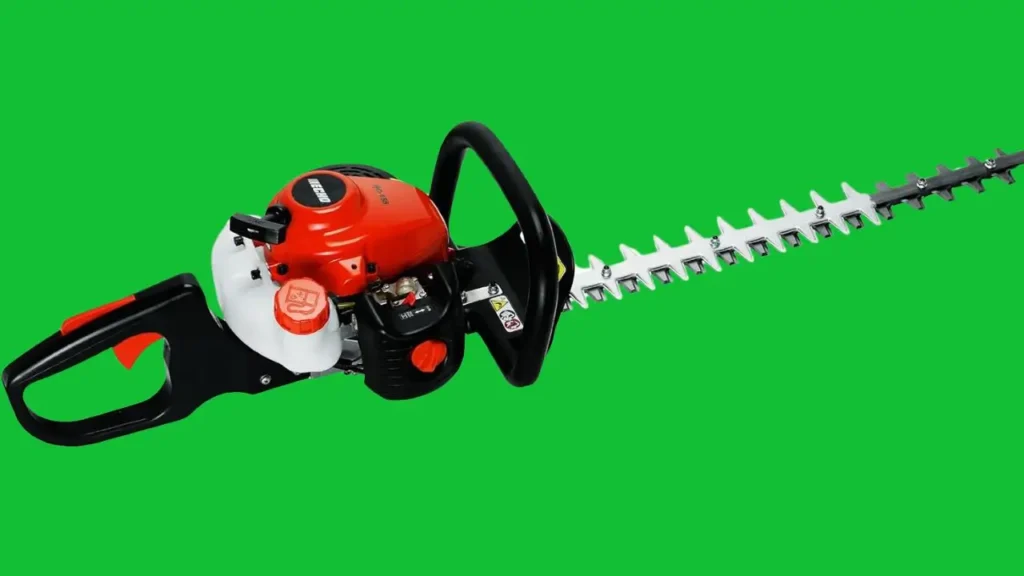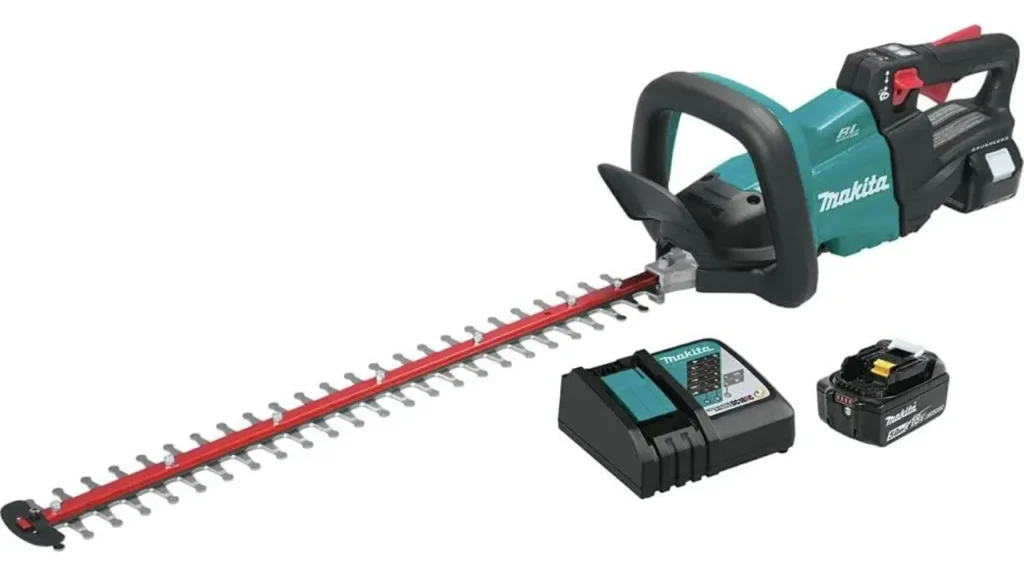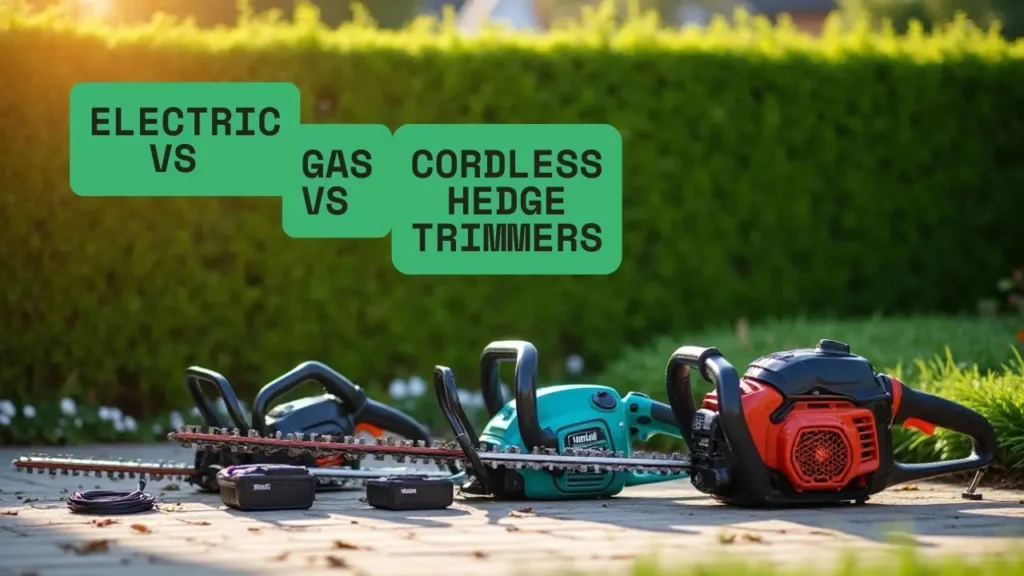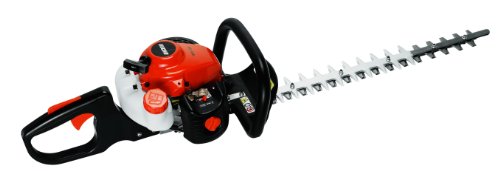When gardeners need to choose a new hedge trimmer, the primary question is often about electric vs gas vs cordless hedge trimmers. More than 85 percent of landscapers choose gas-powered ones because of their high power.
But that doesn’t mean gas trimmers work best for everyone. Electric models weigh about 3 kg so they are much lighter and easier to use for longer tasks. On the other hand, battery-powered trimmers land somewhere in between running for 45 minutes to 1 hour 20 minutes. While these might work well for medium-sized gardens, they might not last long enough to handle bigger spaces.
Gas hedge trimmers can reach impressive cutting speed. Offering up to 4,000 cuts in every minute. However, they produce more noise of 97 dB, while the electric trimmers make noise of 84 dB.
The choice between gas and battery-powered trimmers depends on the size of your garden’s and what matters most to you.
So, when considering electric vs gas vs cordless hedge trimmers, which one truly suits your needs? This guide will help you find the right trimmer by looking at things like power, ease of use, noise levels, and upkeep.
Disclaimer
Affiliate Disclosure
Hi, everyone; this is a heads-up about affiliate links you might see here. Our only purpose in including them is to help you find products easily if you are interested. There is no pressure to buy from these links, but also note that if you buy the products from these links, we may earn a small commission (at no extra cost to you). Your trust is important to us!
Learn more by reading our Full Disclosure.
Image Disclosure
Product images featured in this post are used with written permission obtained from their respective owners. Other illustrative images, such as the hero image, may be generated using AI technology to help visualize concepts discussed.
Content Accuracy & Opinion
The information and opinions expressed in this article are based on our research and/or experience as of the publication date (June 1, 2025) and are intended for informational purposes. While we strive for accuracy, product specifications, availability, and details can change. We recommend verifying any critical information with manufacturers or sellers and considering your specific needs before making any purchasing decisions.
Safety Notice
Using tools like hedge trimmers involves risks. Always read and follow the manufacturer’s safety instructions and operating guidelines for any tool you use. Wear appropriate personal protective equipment (PPE) as recommended. Tool Tested is not liable for any injuries or damages resulting from the use or misuse of products mentioned.
Three Kinds of Hedge Trimmers
The gardening industry provides three main types of hedge trimmers. Each one is designed to handle different type of trimming tasks.
Gas-Powered Hedge Trimmer: Pros and Cons
Gas-powered hedge trimmers deliver impressive power for tackling tough hedges. These tools can cut through thick branches making them a top choice for professionals. In fact, they are favored by more than 85% of landscapers, as shown by this study. Their cutting rate ranging between 3,000 and 4,000 cuts per minute, allows for quick and efficient work on larger projects.

Pros:
- You can run it without limits by refueling.
- It has great power to cut through thick branches up to 1 inch.
- No cord means it offers excellent movement and flexibility.
Weaknesses: The weight feels heavy at first much more than electric models. Owners have to do upkeep like regular maintenance, winter prep, and tune-ups. They also give off exhaust fumes and make more noise compared to electric ones.
Electric (Corded) Hedge Trimmer: Pros and Cons
You plug electric hedge trimmers into a power outlet. They cost between $60 and $150. These tools are light weighing just 3 to 5 kg, so trimming for long periods is easier.

- The electric edge trimmer features 17-inch dual-action hardened steel blade for reduced vibration while trimming (Compar…
- 3.2 amp motor for trimming branches up to 5/8 inch
- Lightweight, compact design of the trimmers for plants is easy to use with less fatigue
Pros:
- The lightweight build helps prevent arm strain.
- Runs more than gas-powered options.
- Easier to maintain with less hassle.
- Costs less upfront in most cases.
Cons: Its key drawback is mobility. You’re limited by the cord’s length and need to stay near an outlet. Electric trimmers also have less cutting strength, and they may have trouble with branches over 3/4 inch in thickness.
Cordless (Battery) Hedge Trimmer: Strengths
Battery-powered trimmers have improved a lot . New lithium-ion batteries can provide run times of 30 to 90 minutes per charge making them a practical fit for most home gardens.

- 5-Position rotating rear handle for increased comfort during vertical and angle trimming
- 3-Speed options (low: 2, 000 SPM, medium: 3, 600 SPM, high: 4, 400 SPM) allowing the operator to match speed to applicat…
- Variable speed trigger for increased operator control
Strengths:
- No cords or fuel give maximum freedom to move around
- Among the three types, it runs the quietest
- Zero emissions mean it is better for the environment
- Needs less upkeep compared to gas versions
It is worth noting that as the battery charge lowers, performance may decrease, which could make longer tasks harder to manage.
Picking Based on the Size of Your Garden
When deciding on electric vs gas vs cordless hedge trimmers, the size of your garden often decides which fits your needs. Choosing the right one saves money while making the job easier without compromising on efficiency.
Best Option for Smaller Gardens: Cordless or Electric
To maintain small gardens with few shrubs lightweight cordless or electric trimmers can work well. The Flymo 18V EasiCut 450 weighs 2.2kg, which helps with moving it around tighter areas. Electric trimmers give steady power the whole time you’re trimming, unlike battery ones that might cut less as the battery runs out.
If you just need to trim a few small bushes, the Ryobi 18V One+ System can give you about 21 minutes of runtime, which covers smaller gardening jobs. Corded models let you work as long as you need but can limit movement. Battery-operated trimmers offer more mobility and still have enough cutting power for simpler tasks.
Best Pick for Medium Gardens: Cordless Trimmer with Extra Battery
Cordless trimmers with spare batteries work well for medium gardens. Landscape expert Brandon Barker says, “Battery-powered trimmers are great options… You just pop a fresh battery on the trimmer, and you’re good to go.”
A model like the Ego Power Plus offers extended battery life so it handles trimming several hedges without stopping. To keep trimming without delays, have a second battery charged. This setup doubles your use time giving you around 60 to 100 minutes, which fits most medium garden needs.
Top Choice for Large Gardens: Gas-Powered Trimmers
Big yards with lots of hedges need gas-powered trimmers. These trimmers run longer without breaks and work better cutting thick bushes and shrubs. So, landscapers go with gas models for big spaces because they have lasting power.
The Husqvarna 122HD60 is a top choice. Its anti-vibration system makes it easier to use for long periods. To handle big gardens or heavy-duty jobs, gas trimmers deliver the strength to handle thick branches up to 1 inch wide.
Price, Care, and Durability
In the electric vs gas vs cordless hedge trimmers choice, price, care, and durability also play a big role, aside from power and mobility. Let’s take a closer look at the pricing, upkeep, and lifespan of different options.
Upfront Cost: From Budget-Friendly to High-End Picks
Hedge trimmer prices vary a lot across types. Manual hedge trimmers cost the least, with prices around $24 to $42. Corded electric ones are a bit more ranging between $48 and $57. Cordless battery-powered trimmers cost more running from $49 up to $118. Gas-powered models come in as the most expensive, with prices sitting between $185 and $268.
When it comes to specific trimmers, the Craftsman corded electric model packs great value compared to its battery-powered rivals. In contrast high-end choices like the Husqvarna Hedge Master tend to cost more but offer top-notch durability and craftsmanship.
Ongoing Maintenance: Mixing Fuel or Charging Batteries
The upkeep needed really depends on the type. Gas trimmers need more care. You have to mix fuel (a 50:1 ratio), change spark plugs once every 100 hours, and check the carburetor often.
Electric models are much easier to handle. As an expert puts it, “With fewer moving parts electric trimmers require less maintenance, which can save on costs in the long run.” For battery-powered ones just focus on taking care of the blade and storing the battery right. Keep it around 40 to 60 percent charged when you’re not using it.
Yearly maintenance costs average about $88 across all types. Gas models tend to cost more, with tune-ups falling between $50 and $90 each year. Blade sharpening costs anywhere from $28 to $59, no matter the kind of trimmer.
Durability and Lifespan: Which One Lasts Longer?
Different factors affect how long each type lasts. Gas models are built but have more parts that can break down as time passes. You can often replace those parts though instead of throwing out the whole unit.
Battery trimmers run into a big challenge—battery life gets worse over time. Lithium-ion batteries work their best for about 3 to 4 years before their capacity takes a hit that you can notice. Doing the right upkeep adds years to any trimmer’s life. Stihl, for example, gives users a “2plus1” warranty extension if they maintain their tools .
The cost of running these tools affects their value in the long run. Using gas trimmers costs between $0.25 and $0.70 an hour, but electric ones become a lot cheaper after the upfront payment.
Usability and Things That Matter
These little details can often tip the balance when picking a hedge trimmer. Let’s break down the practical parts that influence everyday experiences.
Noise and Comfort: What Won’t Hurt Your Ears as Much?
Sound levels differ a lot between types of trimmers. Electric ones run at 84 dB, while gas-powered ones hit around 97 dB making them much noisier. This extra noise can decide if your neighbors will be annoyed during your weekend yard work.
Comfort doesn’t stop at noise. I noticed that weight has a big effect on how tired you feel when using a trimmer for long periods. Corded electric models weigh around 3 to 5 kg so they’re the lightest choice out there. Gas trimmers, which are more powerful, leave you more worn out because of their heavier engines and fuel tanks.
Vibration affects how comfortable a tool feels to use. A landscaper says, “A tool should feel balanced in your hands. A lighter piece of equipment will result in less strain over time.” The Erbauer EHT18-Li demonstrates this balance well. Its 110 cm length helps spread the weight pretty .
Mobility and Reach: Cord Length or Battery Power
Corded trimmers run as long as you need them to, but they limit how much you can move around. A professional puts it , “It’s just too time-consuming managing extension cords and seeking out power outlets.” Because of this, battery-powered models let you move , which is useful in tricky garden layouts.
Pole hedge trimmers come with adjustable heads to trim tall hedges making it easier to reach high spots without using ladders. This design helps gardeners who prioritize safety when handling heights above chest level.
Safety and Choosing Something Easy To Use: What’s Best for Beginners?
Battery-powered trimmers are the simplest to start using. They often come with added safeguards like removable activation keys and multiple switches to keep things secure.
To stay safe, I suggest:
- Wearing eye gear to block flying bits
- Using ear protection with gas-powered types
- Putting on strong gloves to handle vibrations
- You should wear strong shoes that cover your toes. This is to protect your feet
If you’re new to this look for models that include front handle guards, blade tip covers, and automatic blade-stop systems. These features lower the chances of accidents while you get used to your new tool.
Side-by-Side Comparison
To get a clearer picture of electric vs gas vs cordless hedge trimmers, let’s break down their key features in a direct comparison.
Gas Powered
- Cutting Speed: These models reach speeds of 3,000 to 4,000 cuts per minute.
- Weight: They are heavier compared to electric ones.
- Noise Level: At 97 dB, they are louder than both electric and cordless options.
- Initial Cost: Prices for gas-powered models range between $185 and $268.
- Runtime: They run as long as you have fuel to refill.
- Maintenance Needs: High. Maintenance includes tasks like fuel mixing and checking spark plugs and carburetors.
- Best Uses: Larger gardens or professional work benefit most from these models.
- Branch Thickness Handling: They can cut branches up to 1 inch thick.
- Advantages: They offer the strongest cutting power endless runtime, and great mobility.
- Disadvantages: Downsides include heavy weight loud noise frequent maintenance, and exhaust fumes.
Electric (Corded)
- Cutting Speed: The manufacturer does not specify.
- Weight: They weigh between 3 to 5 kilograms.
- Noise Level: At 84 dB, they are quieter than gas-powered models.
- Initial Cost: Electric options tend to be affordable priced between $48 and $57.
- Runtime: They provide unlimited runtime as long as they are plugged in.
- Maintenance Needs: Very minimal upkeep is required.
- Best Uses: Ideal for smaller gardens.
- Branch Thickness Handling: Suitable for branches up to 3/4 inch thick.
- Advantages: These models are lightweight, quiet, and low-cost, with simple maintenance needs.
- Disadvantages: Their use is restricted by cord length and the need for a nearby power source. They also offer less cutting strength.
Cordless (Battery)
- Cutting Speed: No details are provided about the cutting speed.
- Weight: Varies depending on the model chosen.
- Noise Level: They are the quietest option among the three types.
- Initial Cost: Prices range from $49 to $118.
- Runtime: They can run for 30 to 90 minutes per battery charge.
- Maintenance Needs: Low. Focused on blade care and proper battery storage.
- Best Uses: Works well in small to medium-sized gardens.
- Branch Thickness Handling: Not mentioned by manufacturers.
- Advantages: These models do not require cords or fuel, operate , produce no emissions, and need very little maintenance.
- Disadvantages: They are limited by battery life, lose power as the battery drains, and suffer from battery wear over time. I’m sorry, but your input seems incomplete. Can you provide the original text you’d like me to rewrite? I’ll follow the instructions to provide you with the revised text.
Conclusion
When it comes to making your final decision in the electric vs gas vs cordless hedge trimmers debate, picking the right one means finding the tool that truly fits what your garden requires. Gas hedge trimmers are bulkier and noisier but are still the best choice when dealing with large yards or thick branches. Their strong cutting ability and endless runtime make them valuable even though they need more upkeep. This is true for landscapers or people with big outdoor spaces.
On the other hand electric corded hedge trimmers work better in smaller yards if power outlets are nearby. They are lighter more affordable, and deliver steady power. They skip the added weight and maintenance struggles that come with gas models making them a simpler option.
Battery-operated tools have made a space for themselves as great all-rounders. Their ability to work without cords and quieter use draws the interest of people who own medium-sized gardens. However, they still run into issues with short runtimes on larger properties, unless extra batteries are bought.
Gardeners trying to save money should think beyond the price tag when buying and look at long-term costs. Gas-powered trimmers, while having higher upfront costs and needing regular upkeep, can be more expensive over time. On the other hand electric models tend to save money in the long haul. Battery-powered ones sit in between but will need a new battery when it loses efficiency after a few years.
When you pick a hedge trimmer, how comfortable it feels is really important. Things like weight, noise, and vibration can affect how you handle trimming during extended work. Beginners may prefer electric or battery-powered models since they are easier to use and include safety features.
To decide what’s best, think about your garden size how much you can spend, and what you’re comfortable with when it comes to noise and weight. It’s important to find a trimmer that combines power and practicality for your needs. Whether you care more about power, ease of handling, or avoiding cords, there are plenty of tools out there that can simplify hedge maintenance and get the job done .






